The Economics and Statistics Division maintains archives of previous publications for accountability purposes, but makes no updates to keep these documents current with the latest data revisions from Statistics Canada. As a result, information in older documents may not be accurate. Please exercise caution when referring to older documents. For the latest information and historical data, please contact the individual listed to the right.
<--- Return to Archive
For additional information relating to this article, please contact:
March 20, 2025SASKATCHEWAN BUDGET 2025-26 The Province of Saskatchewan tabled its provincial budget for 2025-26 on March 19, 2025.
After a forecast deficit of $660.5 million in 2024-25, the Saskatchewan government expects to return to balance in 2025-26 with a small $12.2 million surplus. Saskatchewan's surpluses are projected to grow modestly in the subsequent three fiscal years, rising to $216.7 million by 2028-29.
Saskatchewan's return to balance relies on a slight decline in expenditures in 2025-26 (-0.1%) while revenues return to growth (+3.2%). In each of the subsequent three fiscal years, Saskatchewan's annual revenue growth is projected to be 3.7% while expenditures rise by 3.4% per year.
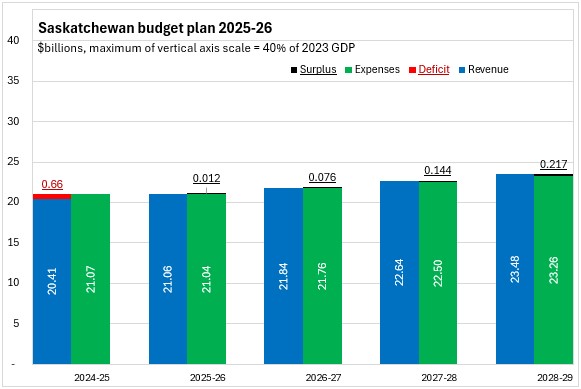
Measured as a share of GDP, the footprint of provincial government in the Saskatchewan economy amounts to 18.0% of GDP in 2025-26 . This is projected to remain fairly stable in the subsequent three fiscal years, edging down to 17.7% of GDP by 2028-29.
Saskatchewan's 2025-26 surplus amounts to 0.01% of provincial GDP estimated for 2025. In subsequent years, the surplus is projected to be 0.1-0.2% of GDP.
Saskatchewan's net debt is projected to rise, reaching 14.6% of GDP at the end of fiscal year 2025-26. Over the subsequent two fiscal years, Saskatchewan's net debt is projected to rise slightly to 15.0% of the province's GDP in 2027-28 before falling to 14.8% of GDP in 2028-29.
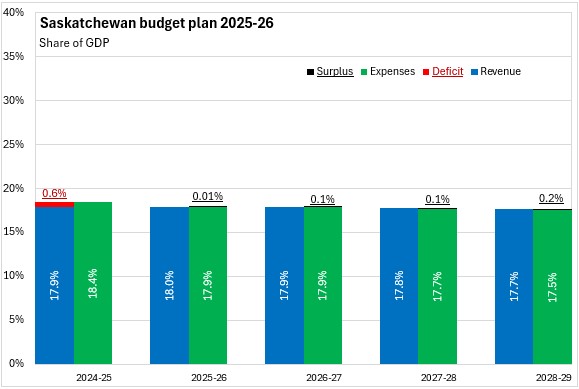
Saskatchewan's 2025-26 Budget expenditures amount to $16,722 per capita, funded by revenues of $16,732 per capita and leaving a small surplus of $10 per capita. Expenditures per capita are projected to rise by $957 in the following three fiscal years while per capita revenues rise $1,112.
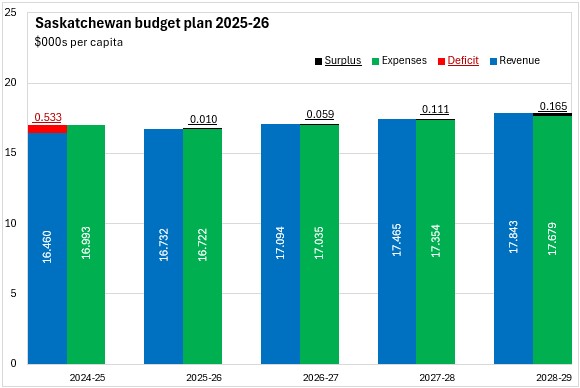
Saskatchewan's revenue projections are somewhat higher than the forecast from the 2024-25 Budget. Saskatchewan's expenditure projections have been revised up by similar amounts.
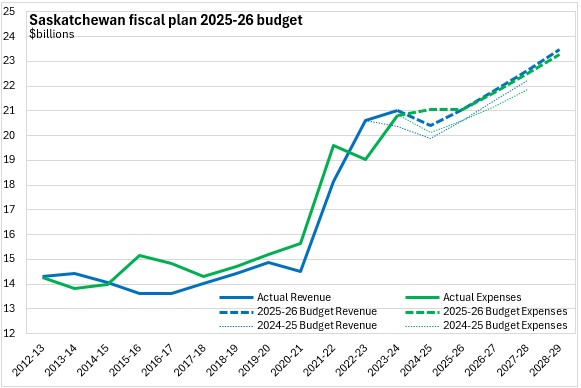
Saskatchewan's outlook for surpluses is little changed compared with the outlook presented in the 2024-25 fiscal plan. Surpluses are projected to be somewhat lower in 2026-27 and 2027-28.
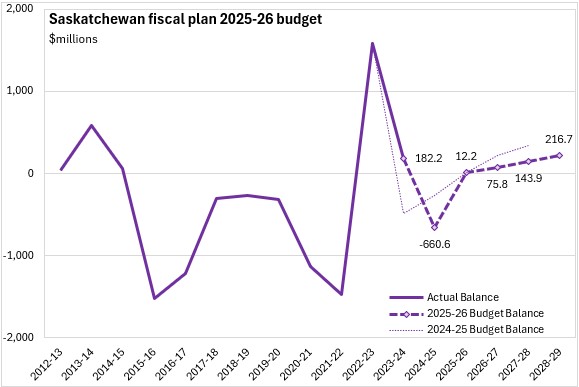
Saskatchewan's economic growth is highly sensitive to resource production and prices, which drive the province's substantial exports. Although there have been years of sharp growth and decline recently, Saskatchewan's outlook for economic growth is projected to be more stable. The Province of Saskatchewan uses an average of private sector forecasts for its economic outlook. Real GDP is projected to grow by 1.8% in 2025, followed by a slight acceleration to 2.0% in 2026. Saskatchewan's nominal GDP is projected to rise by 2.6% in 2025 and by 3.8% in 2026. Saskatchewan's economic growth is expected to be supported by rising production of key commodities (oil, potash, uranium and crops) along with major project investments and recovering consumer spending over the medium term.
When the private sector forecast averages were prepared on February 19, 2025 there were no assumptions made about the impacts of US tariffs. However, the Budget included a separate analysis that suggests a "worst-case" scenario of 25% tariffs for the next year (10% tariffs on energy) could reduce Saskatchewan's exports by over 30%, lowering real GDP by 5.8% and provincial revenues by $1.4 billion. This analysis does not include any adjustments that might result from currency depreciation, interest rate changes or requirements from existing contracts. In light of the uncertainty, Saskatchewan did not make any explicit contingency provisions, noting the province's strong fiscal position is well situated to weather adverse shocks.
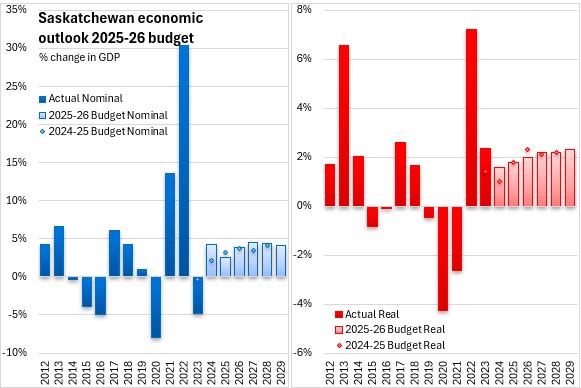
Key Measures and Initiatives
Saskatchewan's 2025-26 Budget emphasizes delivering on important priorities for affordability, education, health care, communities and the economy. In addition to $4.6 billion in provincial government and public utility investments, key measures include:
Affordability
- Implementation of the 2024 Saskatchewan Affordability Act
- Reducing education property tax (estimated at $100 million annually)
- Reinstating the Home Renovation Tax Credit, increasing the First Time Homebuyers Tax Credit to $1,575
- Making the Provincial Sales Tax rebate on new home construction permanent
- A four-year plan of increases to the Low Income Tax Credit
- Increasing Income Support and Assured Income for Disability by 2%
Education
- Increasing funding by $130 million for a new collective agreement for teachers and to address rising enrolment of students
- New programming to fund school playgrounds ($4 million annually)
Health
- $15 million increase in health funding to reduce surgical wait times and $30 million to improve capacity at Saskatoon City Hospital
- Enhancing and expanding pediatric care
- Adding 30 full-time positions to enhance kidney dialysis services
- Expanding the Virtual ER Physician Program for 25 smaller emergency department locations
- Building five new Patient Medical Home sites
- Expanding cancer screening programs
- Adding 27 nurse practitioners in rural and remote communities
- Enhancing immunization programs (HPV, shingles, RSV)
- Expanding Glucose Monitoring Program for young adults and seniors
- $7 million addition for continuing care and additional programming to improve home care coordination
- Adding 500 addictions treatment spaces
- Implementing Virtual Access to Addictions Medicine
- Increasing funding for the Bridgepoint Centre for Eating Disorder Recovery
- Adding 10 more training seats for family medicine, anesthesia, plastic surgery and other specialties
Community
- $9 million for multi-year repair and renovations in 285 Saskatchewan Housing Corporation units in urban areas
- $5 million for a Rental Development Program
- $10 million increase for services for adults with intellectual disabilities
- $20 million increase in funding for community based organizations
- Increase Community Rink Affordability Grant to $5,000 per ice surface
- $1 million for the Saskatchewan Regional Parks Association to build new seasonal campsites
Economy
- Establishing a new Small and Medium Enterprise Investment Tax Credit - 45% non-refundable credit for investment in equity of an eligible small or medium enterprise
- $2 million increase for Saskatchewan Apprenticeship and Trade Certification Commission to add 150 apprenticeship training seats for skilled trades
- Increasing Northern Skills Training funding to $1 million
- Establishing a new Low Productivity and Reactivation Oil Well Program and investing $2 million to modernize business processes for regulatory oversight
- $3 million to upgrade equipment at Canadian Light Source research facility at the University of Saskatchewan
Saskatchewan Budget 2025-26
<--- Return to Archive